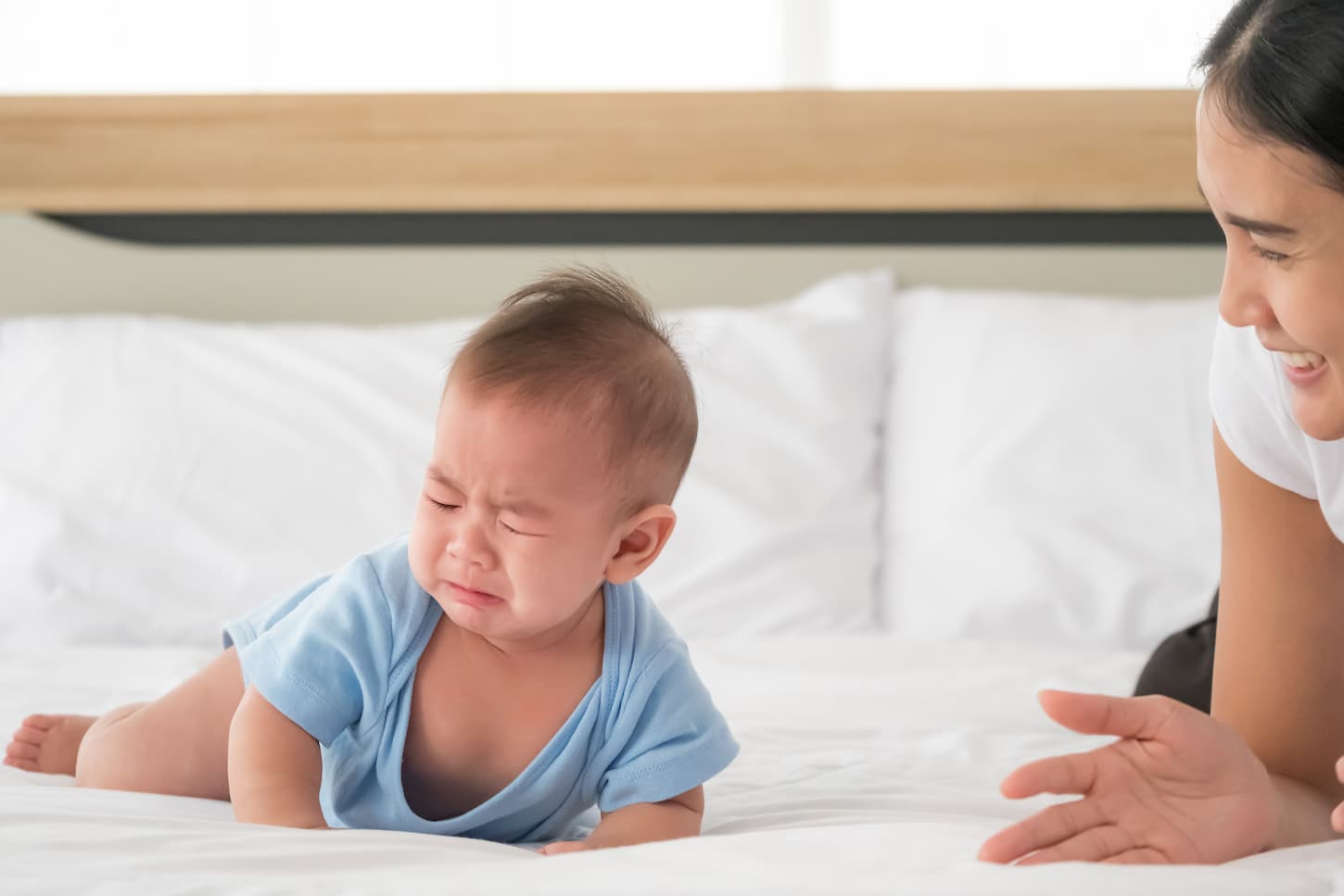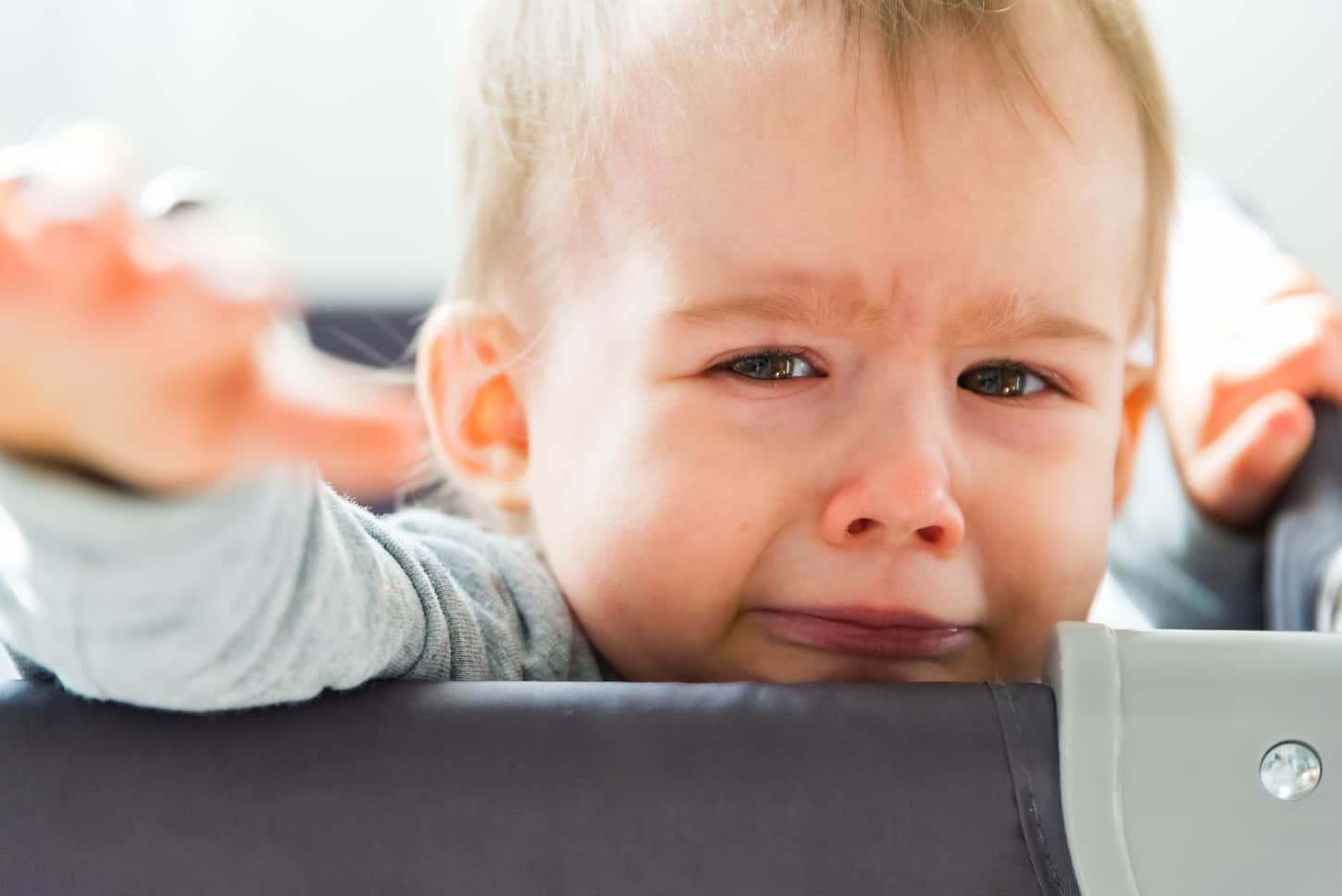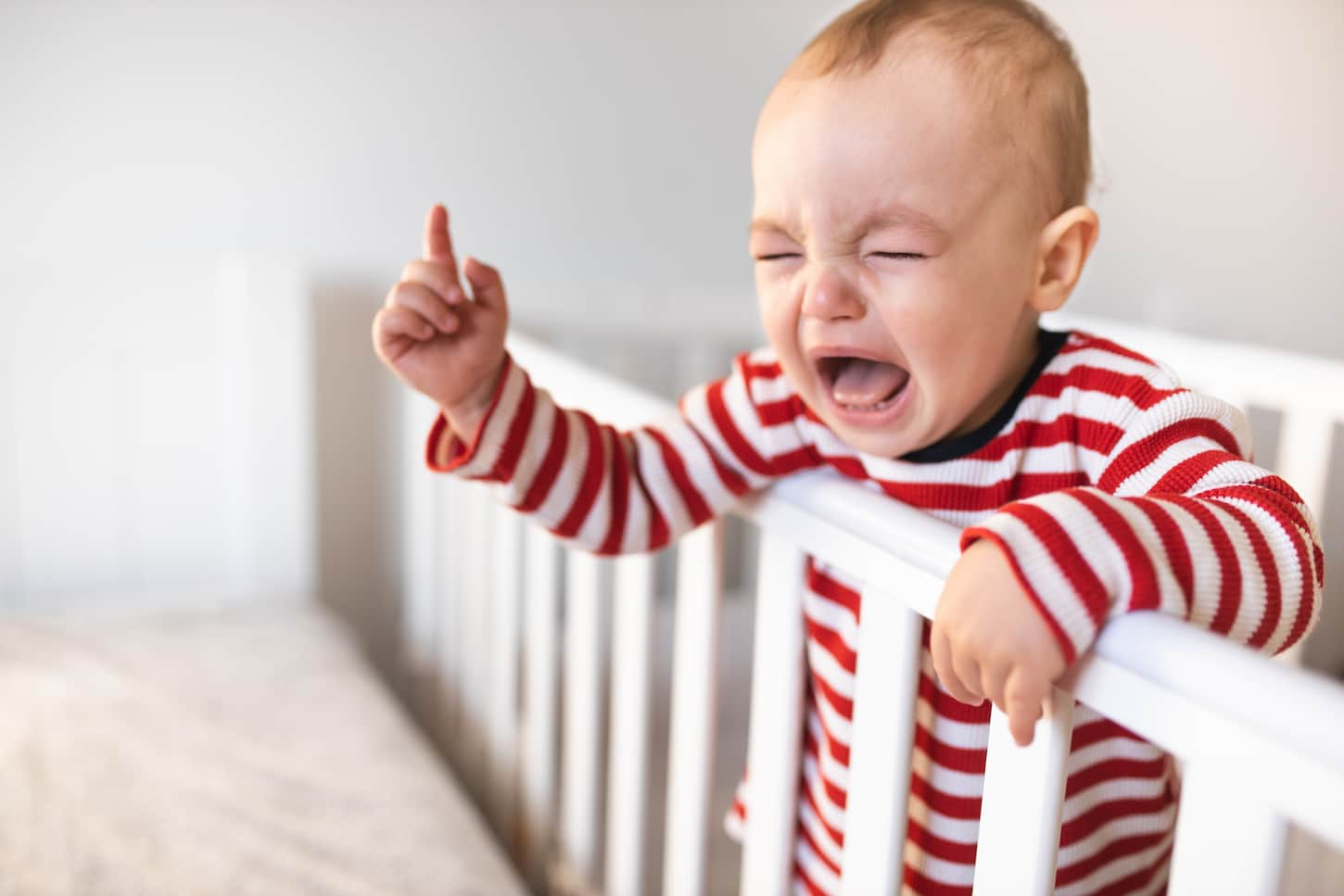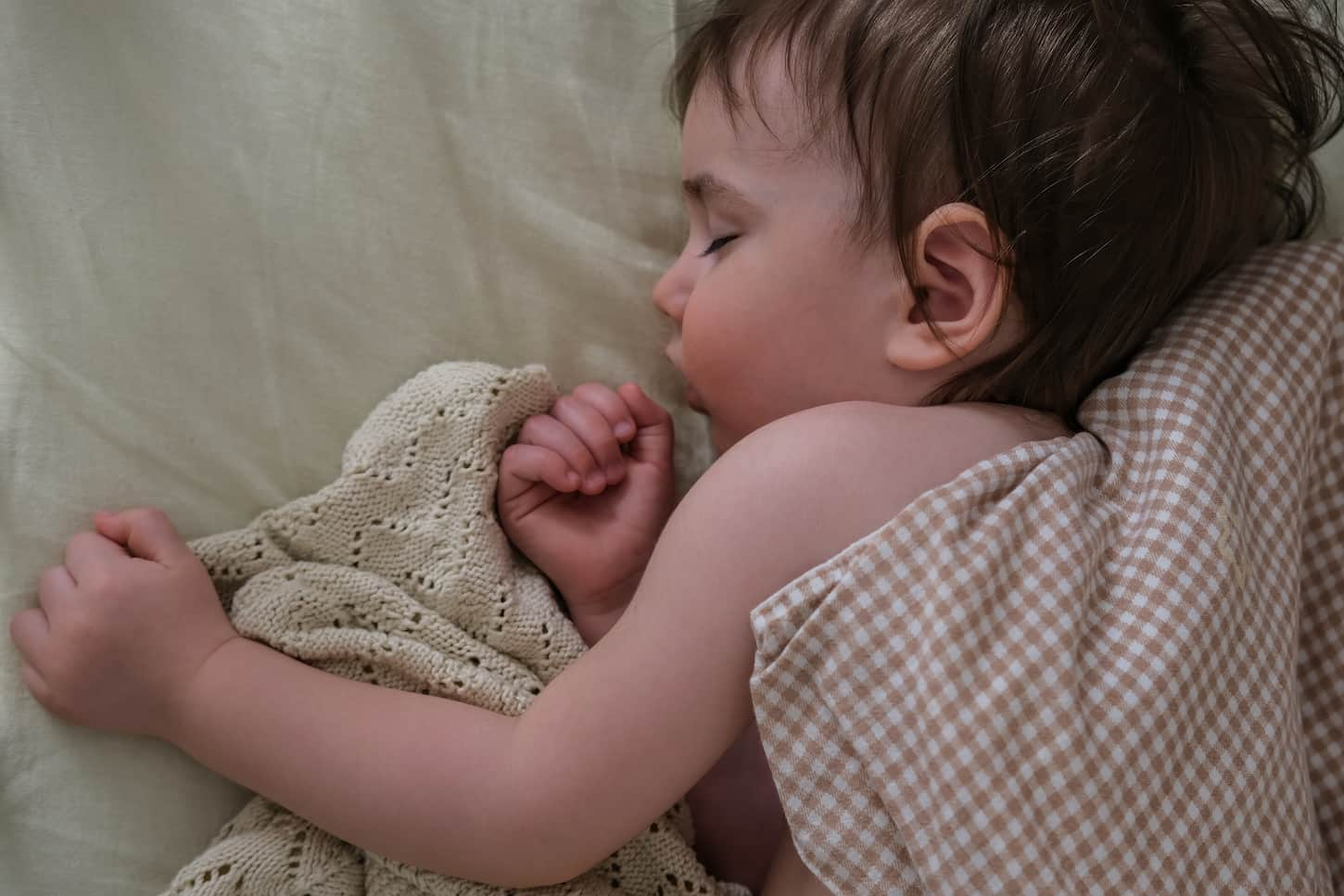Letting a baby cry on purpose can be a highly controversial topic. Especially because it seems like every parent out there has their own very emotional ideas on this subject. Even so, this topic is one that we need to talk about. Is it OK to let a 1-year-old cry it out?
Letting your 1-year-old cry it out is okay if done safely over up to 3-7 days. Getting severe sleep disruption under control is worth a few tears – with the average number of tears required being of an hour’s worth of crying the first night. Cry-it-out can be okay for some parents who need a reset button.
I am not saying that you have to use cry-it-out. It definitely won’t be right for all families. So if it isn’t right for you? That’s fine. Don’t do it. Instead, check out my complete guide to no-tears sleep training methods.
But if all other options have been tried (and failed miserably), then you may want to consider using cry-it-out as a last resort – or as a reset button on your sleep training endeavors. Ready to do this? Let’s dive in.

Letting a 1-Year-Old Cry it Out is OK
Being one is hard. Or so it seems, based on the epic quantities of tears that 1-year-olds shed on a regular basis. (I don’t actually remember being 1, and I’m willing to bet you don’t, either.) And the tears only seem to get worse if the child is exhausted. Not that I’m pointing a judgemental finger at a cranky, overtired one-year-old. I get cranky when I’m exhausted, too!
In any case, based on talking to hundreds and thousands of parents, there is a significant percentage of us who have had to rely on cry-it-out (sometimes abbreviated as CIO) to get our children on a healthier sleeping pattern.
Of the parents I’ve talked to, it seems like about half of parents use a cry-it-out method at one point or another. This is not a scientific survey by any means – there are some major audience and confirmation biases going on here. But even so, it’s worth noting that just because you’re considering using cry-it-out doesn’t make you abnormal or evil. It means you’re in a very normal part of the population.
Now, maybe we don’t use CIO for every child – or maybe we do one round of it as a jump start. But it is a useful tool – when done right. And it’s okay to use it.
Do most of us feel bad about using cry it out? Yes – to one degree or another. No parent likes seeing or letting their child cry. It’s heartbreaking. But if sleep is beyond necessary now, then cry-it-out is the best tool available to help everyone get the sleep they need now.
Cry-it-out works within a week, rather than the 2-weeks-minimum timeline for other, tears-free sleep training options. Especially since, in my experience, the tears-free options really need a lot longer than just two weeks – a month seems more realistic.
So if you need sleep yesterday (or at least now), then letting your child sleep train via a cry-it-out methodology is okay. It’s just fine, especially since you won’t be letting them cry for too terribly long.
How to Do Cry-it-Out with a 1-Year-Old
Ready to do some extinction (cry-it-out) sleep training with your one-year-old? That’s fantastic. There are several versions, so it’s time to think about if you’re going to do pure extinction, a modified check-in system, or what.
But don’t worry – all cry-it-out sleep training methods, all have the same basic 6 steps. So let’s go over those really quickly.
- Do your bedtime routine with your child.
- Put your child to bed. Ideally, you want your one-year-old still awake but very drowsy. Avoid a too-late bedtime, as you don’t want them to be overtired or exhausted.
- Let your child self-settle and even cry for a predetermined amount of time.
- Check-in on your child at pre-determined intervals via your predetermined method of choice (in-person, via a baby, or video monitor).
- If you choose to comfort your child, do so via the predetermined method (pat them on the back, pick them up for a moment, or talk to them in a low, soothing voice) before putting them back in bed.
- Repeat steps 3-5 as needed until your child falls asleep.
See? Covers all the methods. Now, if you’d like details on the specific methods, be sure to check out my complete guide to cry-it-out by clicking here.

How Long to Let Your 1-Year-Old Cry it Out
Based on both my experience and talking to other parents about cry-it-out, here is how long you may need to let your 1-year-old cry it out (also called extinction sleep training).
Most children will cry for 1-2 hours that first night of dedicated CIO sleep training. Extinction sleep training should be completed within 3 to 7 days.
Usually, the first night is the worst. On subsequent nights the crying will shorten significantly until it goes away or is just some mild whimpering. However, in some instances (like our own), some 1-year-olds will cry more like this:
- Night one: crying for 1-2 hours
- Night two: cries for 30 minutes
- Night three: cries for an hour
- Night four: cries for 45 minutes
- Night five: cries for 20 minutes
That’s what happened to several of our children at that age – the first night was definitely the worst. But then after some initial improvement on night two, the next night was a lot worse. That crying resurgence can be seen anywhere from nights 3-5.
In any case, it’s a week’s worth of tears. And in a worst-case scenario, it’s an hour’s worth of tears for a week. That’s how long to let your baby cry if you’re using a CIO sleep training methodology.
Now, will this work for every child? No, of course not. Not every method works for every child. But that’s okay – we’ll talk about when this doesn’t work and what to do next later on in this article. But first, I want to mention an important truth.
It’s OK to Let Your Baby Cry (if nothing is wrong)
That’s right: it’s okay to let your baby (of any age) cry if there’s nothing wrong. Now, if there’s something wrong, please go fix that!
But if your child has:
- all of their physical needs met (clean diaper, full tummy, clean clothes);
- had their emotional needs met (lots of cuddles and interaction during the day);
- and has all of their other needs met during the daytime.
Then it’s okay to let them cry at bedtime for a little bit. Or even if it’s not bedtime, it’s still okay.
Do you remember learning about the Period of Purple Crying in newborns? It usually peaks at 5-12 weeks of age – and it’s just a period in the evening where some (not all) babies cry for no known reason. During this time, all of the relevant, acronym-ed agencies and health departments have a solid piece of advice.
Here it is, summarized.
- Make sure your baby is in a safe place and has their needs met.
- Then, put them down and walk away – and let them cry.
- It’s much better to let your child cry in another room than to hold them and lose your temper. This helps prevent shaken baby accidents.
Now, a 1-year-old is biologically and developmentally different than a newborn. But the advice holds true for children of all ages.
If you need a mental break from the crying, put your baby safely in their crib – and leave the room. Give yourself a few moments to calm down. It’s okay. And it’s much better than the alternative of losing your temper – and potentially doing something in anger that could impact the rest of everyone’s lives.
When the Cry-It-Out Method Won’t Work for a 1-Year-Old
Now, I promised you earlier we’d talk about what to do if cry-it-out doesn’t work – or if it’s not following the 3-7 day timeline. So let’s do that now.
If extinction sleep training isn’t working for your child, you’re going to know it. Even so, here are the most common reasons why cry-it-out won’t work with a one-year-old.
Your child vomits after crying.
This is the biggest reason that CIO fails for some children at a year old. If your child is a vomits-after-crying type, it’s okay. Clean the vomit up – and then consider a different sleep training method that requires fewer tears. Here’s my guide to gentler sleep training methods to get you going.
There’s a diaper incident.
Crying can often cause a surprise poopy diaper. If it were just a pee diaper, you could get away with ignoring it for a bit. But poop? That needs to be cleaned up ASAP – and it can reset your crying clock. If the bedtime poop becomes a regular problem, then you may need to go to a gentler sleep training method. Usually, though, this is a once-off problem and you can keep going – just treat the diaper change as an in-person check-in.
Your child is an escape artist.
If your 1-year-old can escape their crib already, you have my sympathy for having an advanced child. Most children can’t escape a crib until at least 18 months of age, but this could happen. If your child is an escape artist, you’ll need to move to bigger-kid-appropriate sleep training techniques – click here to read my article about those.
Your baby won’t stop crying.
This issue is a rare one, but I’ve seen it enough to mention it. Some babies get too worked up to do cry-it-out – and they need your physical comfort to calm down enough to sleep. If that’s the case, then a CIO sleep training session probably won’t work for your child. You’re going to need to do a slower, gentler technique.
You can’t handle it.
If this sleep training method is getting to you or your partner, then this isn’t the right technique for your family. It’s okay. Change to something else. There’s no shame in changing to something that will work better for your family. In fact, that’s the ideal: finding what works and moving forward.
If an extinction style of sleep training isn’t working, that’s okay. There are a lot of other options. Again, for suggestions on gentler methods, read my article on what gentler sleep training methods there are.

Sleep Training and 1-Year-Old FAQs
Now, let’s make sure that you’ve got all of your cry-it-out sleep training-related questions answered. Here are some of the most commonly-asked questions I’ve asked, researched, or been asked by parents like you.
Oh, and if you don’t see your specific question (or answer), just shoot me an email. I’ll try to respond to as many emails as I can – and I’ll get your question added to this post. To find out how to email or contact me, click here.
Does Cry it Out Cause Damage?
Scientific studies have found that short-term, cry-it-out style sleep training is generally safe. It can cause a slight, temporary increase in cortisol (the stress hormone), but once sleep training is done, those stress hormone levels go down more than in babies who haven’t done any sleep training at all and are still overtired.
Read my article on sleep training safety for more information.
Why Does My 1-Year-Old Cry Every Night?
Some children cry every night. It can be because they’re tired or because they’re wanting snuggles. Or they could be poopy and need a diaper change. There are countless reasons why your child is crying every night.
In order to figure out why they’re crying, though, see what’s going on right before they start crying.
- If your child is straining, then it’s probably the poopy diaper.
- If there is crying every night at about 8 PM, then your child is probably exhausted. You may want to address a bedtime change.
- Or if your child is crying every night at a reasonable dinner time, then maybe they just don’t like your cooking. I’m mostly kidding – although my picky-eating kids didn’t like what I made, either. One of them ended up having a food allergy, though.
In any case, see what’s going on. Then, make a reasonable guess as to the cause. See what you can do to fix that – and then evaluate if that fixes the crying.
If there’s absolutely no other visible reason for the crying, then it’s probably related to being overtired and/or overstimulated.
Is It Too Late to Sleep Train a 1-Year-Old?
No, it’s never too late to sleep train a one-year-old. In fact, it’s not too late to sleep train an older child.
Although, as a child gets older we usually quit calling it “sleep training” and start calling it “practicing good sleep hygiene” or “getting a good night’s sleep.”
And it’s totally possible to sleep train an adult, too. We need a good, reasonable bedtime, too! Even we parents get cranky without a good night’s sleep. So make sure you’re taking care of your older children and yourself – get to sleep at a decent hour.

Related Questions
How Do You Know that Sleep Training is Working? Sleep training is working if steady, measurable progress towards a good night’s sleep and overall happiness improves. Results are usually measured in months rather than days. Read my article on how to tell if sleep training is working for more information.
What’s the Best Way to Sleep Train a 1-Year-Old? The best way to sleep train a one-year-old is by whatever method works to help them get enough sleep to be rested and happy. There are lots of methods to pick from, so choose the one that works best for your family.
What Are Sleep Cues? Sleep cues or signs are physical indications that someone is tired, like rubbing their eyes. Read my article on how to recognize and use your child’s sleep cues for more details and ideas.